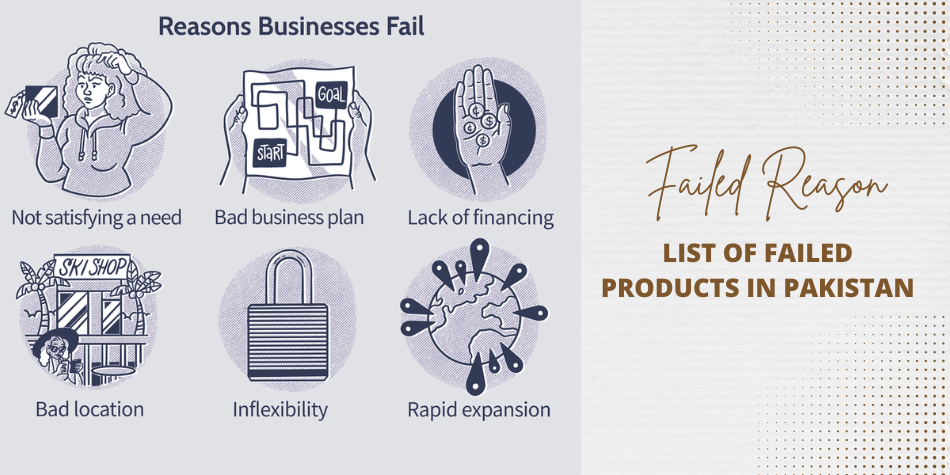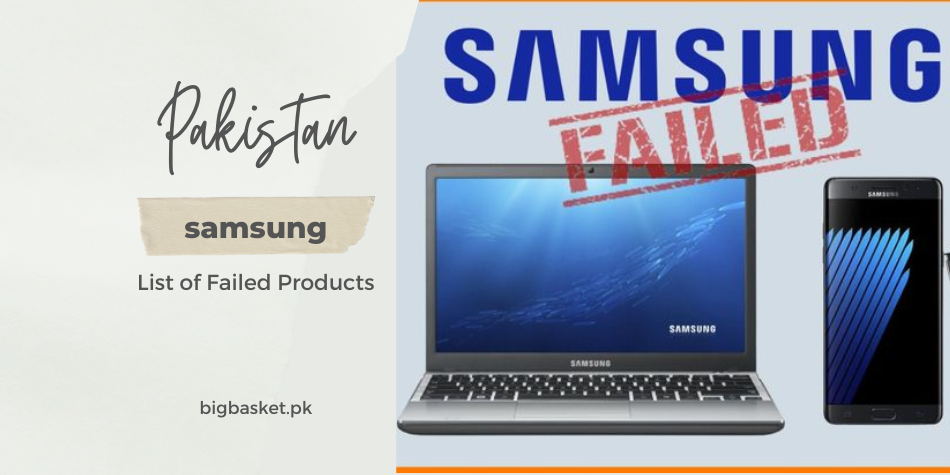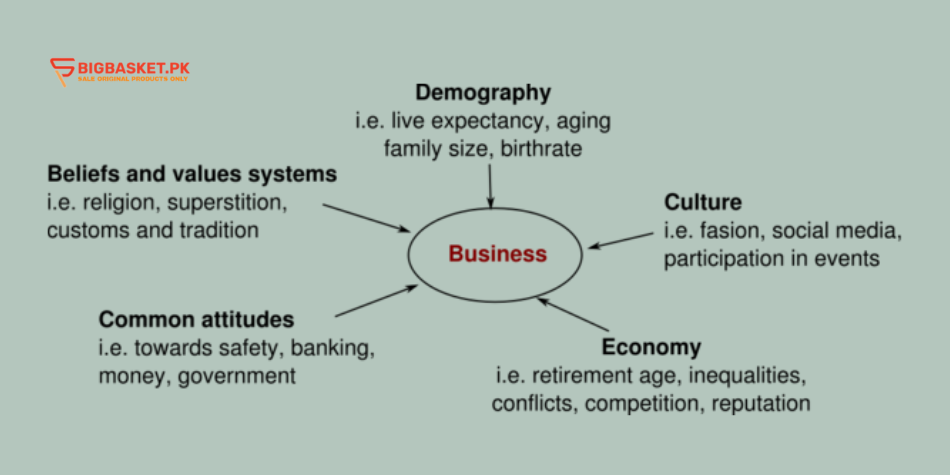List of Failed Products in Pakistan

List of Failed Products in Pakistan, Welcome to a comprehensive exploration of failed products and the invaluable lessons they provide. In this series, we delve into the intricacies of products that faced setbacks, aiming to unravel the underlying factors contributing to their demise. From missed market trends to strategic missteps, each case offers insights crucial for businesses and entrepreneurs. Join us on this journey of discovery as we navigate through the world of failed products, examining the complexities that shape the landscape of innovation and consumer preferences.
Brief Overview of List of Failed Products in Pakistan
Uncover the stories behind failed products, understanding the challenges and pitfalls that led to their downfall. From ambitious tech gadgets to once-hyped consumer goods, this series provides a detailed examination of the factors that contributed to the demise of these products. Gain a nuanced understanding of the dynamic forces shaping the market and learn from the mistakes that turned potential successes into cautionary tales.
Importance of Analyzing Failures
Analyzing failures is an essential aspect of fostering growth and innovation. By dissecting the reasons behind product failures, businesses can glean valuable insights that inform future strategies. Understanding consumer expectations, market dynamics, and internal processes provides a roadmap for avoiding similar pitfalls. Through this examination, companies can pivot, refine their approaches, and build resilience in a competitive landscape, ultimately improving their chances of delivering successful and sustainable products.
Purpose of the List
The purpose of this list is to serve as a comprehensive resource for entrepreneurs, businesses, and enthusiasts eager to learn from the failures of the past. By compiling a curated selection of failed products, we aim to provide a nuanced understanding of the diverse challenges faced by innovators. This list serves as a cautionary guide, offering actionable insights to help businesses navigate the complexities of product development, marketing, and consumer engagement. Explore the reasons behind product failures and unlock the keys to sustained success in the ever-evolving world of commerce.
Failed Technological Products
Examples of Failed Gadgets and Devices
Explore the graveyard of technological innovations as we highlight some infamous examples of failed gadgets and devices. From ill-fated smartphones to ambitious wearables, this section unveils the stories behind products that fell short of expectations. Dive into the intriguing tales of products that missed the mark, unraveling the complexities of technological advancements that faced setbacks in the fast-paced world of innovation.
Reasons for Technological Failures
Understanding the nuanced reasons behind technological failures is crucial for navigating the ever-evolving landscape of innovation. Explore the multifaceted aspects that contribute to the downfall of gadgets and devices. From technological glitches and design flaws to misaligned marketing strategies, this section delves into the intricate web of challenges that led to the demise of once-promising technological products. Uncover valuable insights into the pitfalls that innovators face, providing a roadmap for avoiding similar setbacks in the relentless pursuit of cutting-edge advancements.
Unsuccessful Consumer Goods
Failed Food and Beverage Products
Embark on a journey through the world of consumer goods as we shine a light on failed food and beverage products. Delve into the stories of culinary creations that failed to captivate taste buds or suffered from strategic missteps. From ill-fated snacks to misguided beverage innovations, explore the reasons behind these culinary letdowns and gain insights into the dynamic and competitive nature of the consumer goods industry.
Issues Leading to Consumer Goods Failures
Unravel the intricacies of consumer goods failures by examining the common issues that contribute to their downfall. From branding blunders to quality control challenges, this section explores the diverse range of factors that can lead to the demise of products in the consumer goods market.

Learn from the missteps of the past as we analyze issues related to market trends, consumer preferences, and operational inefficiencies. This exploration provides a comprehensive understanding of the challenges faced by brands in delivering successful consumer goods to the market.
Flopped Fashion and Beauty Products
Examples of Fashion and Beauty Failures
Embark on a journey through the world of style and glamour as we uncover examples of fashion and beauty products that faced a less-than-stellar reception. From ill-conceived fashion trends to beauty products that failed to make the cut, this section explores the stories behind these flopped creations. Uncover the missteps, design blunders, and market misreads that led to the downfall of once-promising fashion and beauty endeavors.
Contributing Factors in the Fashion and Beauty Industry
Dive into the intricacies of the fashion and beauty industry and explore the contributing factors that often lead to the failure of products. From rapidly changing trends to marketing mishaps and quality concerns, this section delves into the dynamic challenges faced by brands in the pursuit of aesthetic perfection. Gain insights into the ever-evolving consumer preferences, the impact of social media, and the importance of adaptability in an industry where staying in vogue is key to success.
Failed Marketing Campaigns
Notable Examples of Failed Marketing Efforts
Embark on an exploration of marketing mishaps as we uncover notable examples of failed marketing campaigns. From major brands to ambitious startups, this section unveils the stories behind marketing endeavors that missed the mark. Analyze the missteps, controversial choices, and strategic errors that led to these campaigns falling flat. Delve into the world of advertising blunders and discover how even well-established brands can stumble in the pursuit of consumer engagement.
Lessons Learned from Marketing Failures
Explore the valuable lessons learned from the failures of marketing campaigns. This section delves into the reasons behind these misfires, whether due to cultural insensitivity, poor timing, or a lack of understanding of the target audience. By examining the missteps of others, gain insights into the principles of effective marketing. Understand the importance of market research, cultural awareness, and aligning with brand values. These lessons serve as a guide for marketers and businesses aiming to navigate the complex terrain of consumer perception and engagement successfully.
Economic and Business Failures
A. Companies with Failed Business Models
Enron Corporation
Explore the dramatic rise and fall of Enron Corporation, once hailed as an energy giant. This cautionary tale reveals how a flawed business model, marked by accounting irregularities and corporate misconduct, led to Enron’s spectacular collapse in 2001. Uncover the intricate web of financial engineering and ethical lapses that shattered investor trust and resulted in one of the most infamous business failures in history
Blockbuster Video
Delve into the demise of Blockbuster Video, a company that failed to adapt its business model to the digital age. Once synonymous with movie rentals, Blockbuster struggled to compete with online streaming services. The refusal to embrace changing consumer preferences ultimately led to bankruptcy. Analyze the lessons learned from Blockbuster’s failure, emphasizing the importance of innovation and staying attuned to market shifts.
B. Economic Factors Influencing Business Failures
Explore the economic intricacies that contribute to business failures, shedding light on external forces that impact companies’ viability.

a. Market Downturns
Businesses often face challenges during economic downturns, with reduced consumer spending affecting profitability. Examining how companies weather economic recessions provides insights into strategic planning and resilience.
b. Interest Rates and Financing Costs
Fluctuations in interest rates can significantly impact businesses, affecting borrowing costs and capital investment. Understanding the interplay between interest rates and business performance is crucial for financial sustainability.
c. Global Supply Chain Disruptions
The interconnected nature of global supply chains exposes businesses to risks such as natural disasters, geopolitical events, or pandemics. Evaluating how companies navigate and adapt to supply chain disruptions offers valuable insights into risk management.
d. Regulatory Changes
Shifts in regulatory environments can pose challenges for businesses, requiring them to adapt quickly to new compliance standards. Examining how companies respond to regulatory changes provides lessons in agility and corporate governance.
e. Currency Fluctuations
For multinational corporations, currency fluctuations can impact earnings and competitiveness. Understanding how companies hedge against currency risks sheds light on effective financial management strategies.
Social and Cultural Factors in Product Failures
Cultural Misunderstandings
Explore the impact of cultural misunderstandings on product failures, where a lack of cultural sensitivity can lead to misinterpretations and negative consumer reactions. Case studies highlight instances where products failed due to insensitivity to cultural nuances, language barriers, or inappropriate representations.
Understanding the importance of cultural awareness in product development and marketing is crucial to building global brands that resonate positively with diverse audiences.
Social Media Backlash
Dive into the role of social media backlash in contributing to product failures. In the age of instant communication, social media platforms amplify consumer voices, allowing rapid dissemination of opinions and critiques. Examining cases where products faced severe backlash on social media provides insights into the power of online communities and the need for companies to be vigilant in managing their online presence. Strategies for mitigating and responding to social media criticism are essential for companies seeking to navigate the digital landscape successfully.
Conclusion
The exploration of product failures reveals a multifaceted landscape where economic, cultural, and strategic factors intersect. From failed business models to social media backlash, each case serves as a valuable lesson for entrepreneurs, businesses, and marketers alike. Understanding the intricate web of challenges, whether economic downturns, cultural misunderstandings, or social media scrutiny, is pivotal for navigating the complexities of the modern business environment.
By delving into these failures, we gain insights into the importance of adaptability, cultural awareness, and strategic foresight. Recognizing the power of consumer voices amplified through social media underscores the need for transparent communication and responsiveness. As businesses learn from past missteps, they can forge a path toward resilience, innovation, and sustained success.
Ultimately, the analysis of product failures offers more than a retrospective glance; it provides a forward-looking perspective. Armed with these insights, businesses can navigate the ever-evolving landscape, mitigating risks, and embracing opportunities for growth. In the dynamic world of commerce, understanding the intricacies of failure is an integral part of achieving enduring success.
FAQs
Why do products fail in Pakistan’s market?
In the dynamic and competitive market of Pakistan, several factors contribute to the failure of products. These include inadequate market research, cultural misalignment, pricing issues, and insufficient understanding of consumer needs. Companies must carefully analyze these aspects to ensure the success of their products in the Pakistani market.
How does cultural misalignment impact product failure?
Cultural misalignment occurs when a product does not resonate with the cultural values and preferences of the Pakistani population. Products that fail to address local customs, traditions, and lifestyles often struggle to gain acceptance. Successful products are those that strike a balance between global appeal and cultural sensitivity, ensuring they connect with the diverse consumer base in Pakistan.
What role does pricing play in product failure?
Pricing is a critical factor influencing product success or failure. Products priced too high for the average consumer may face rejection, while those priced too low may be perceived as low quality. Striking the right balance is crucial. Companies need to conduct thorough market research to understand the purchasing power and price sensitivity of Pakistani consumers to avoid pricing pitfalls.
How important is market research in preventing product failure?
Market research is the backbone of a successful product launch. It helps companies understand the needs, preferences, and behavior of the target audience. Lack of proper market research often leads to the development of products that fail to meet consumer expectations. Comprehensive market analysis guides product development, ensuring it aligns with the demands of the Pakistani market.
Can inadequate marketing contribute to product failure?
Absolutely. Products need effective marketing strategies to create awareness and build a strong brand presence. Inadequate marketing efforts, including poor advertising, insufficient online presence, and lack of promotional activities, can lead to products being overlooked by consumers. Successful products invest in robust marketing campaigns to ensure visibility and recall among the Pakistani audience.
How does competition impact the success of products in Pakistan?
Pakistan’s market is highly competitive, with numerous brands vying for consumer attention. Products that fail often do so because they are unable to differentiate themselves from competitors. Unique selling propositions, innovative features, and effective branding are essential for standing out in a crowded marketplace. Companies must carefully analyze the competitive landscape to identify and address potential challenges.
What are common mistakes made in product development?
One common mistake is rushing the product development process without sufficient testing and refinement. Another is neglecting to adapt products to local tastes and preferences. Additionally, ignoring feedback from initial launches can lead to long-term failure. Successful products involve consumers in the development process, iterate based on feedback, and prioritize quality and adaptability.
How can companies recover from product failure in Pakistan?
Recovering from product failure requires a strategic approach. Companies must conduct a post-mortem analysis to identify the root causes of failure. They can then reposition the product, rebrand, or make necessary modifications based on customer feedback. Open communication with consumers, acknowledging mistakes, and offering improved versions can help rebuild trust and give the product a second chance in the Pakistani market.









